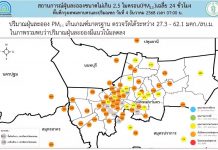BANGKOK – As a multicultural society, the southernmost region of Thailand has unique cultural identities. The Government has a policy to adopt a cultural dimension to promote better understanding among the people of different faiths and contribute to peace-building in the deep South.
Minister of Culture Vira Rojpojchanarat explained that the Ministry of Culture has used culture to create good citizens, bring about national reconciliation, generate income for communities, and enhance international relations. Moreover, the cultural dimension has also been adopted to bring happiness and stability to the people in the southern border provinces.

In this regard, he said, the local distinctive culture will be preserved and promoted in these provinces, which serve as a gateway to other ASEAN countries. This will help encourage the people of Thailand, with different cultural and religious backgrounds, to be united and live together happily and peacefully.
Speaking at the opening ceremony of the Tourism Festival and the Limkoneaw Goddess Celebration in Pattani province, Permanent Secretary for Culture Apinan Poshyananda cited cultural diversity as the prominent feature of this southern border province. The festival is a way to show the pride of Pattani residents to all visitors.
He believes that the promotion of cultural tourism will encourage more people to visit Pattani and other southern border provinces, such as Yala and Narathiwat. These provinces are regarded as the gateway to the ASEAN region.
The Limkoneaw Goddess Celebration is organized in February each year after the Chinese New Year celebration. It reflects a harmonious mixture of Thai, Chinese, and Muslim cultures. A legend has it that Limkoneaw was born in the 15th century in China. An aristocrat made a false charge against her brother, who was a government official. Her brother decided to flee from China and boarded a ship to southern Thailand. He arrived in Pattani and became a trader, and later, he was assigned by the Pattani governors to cast three massive cannons. One of them is Nang Phraya Tani, the biggest cannon ever cast in Thailand. Because of his excellent work, the Pattani governor allowed Limkoneaw’s brother to marry his daughter.
Limkoneaw looked after her mother alone, while her brother lived far away. Feeling deep sympathy for her mother, she offered to travel to Thailand to persuade him to return home. Limkoneaw encouraged her brother to go back many times, but he refused, since at that time he was assigned to handle the important task of constructing the Krue Se (Kersih) Mosque. Construction began in 1578 but the building was never finished, yet the main structure remains.
In order to show her sense of obligation to her mother, despite her failure to persuade her brother to return home, Limkoneaw decided to commit suicide under a cashew nut tree. She was then called a goddess, so a wooden sculpture in her image was built where people could pay homage to her. Krue Se Mosque has become one of the main places of interest in Pattani and it is located near the Limkoneaw Shrine.
Pattani province, which is predominantly Muslim, holds this celebration as its major cultural event each year, with many tourism activities, as well. The distinctive cultural variety has been used as one of its strengths to promote local tourism and bring about social harmonization in the deep South of Thailand, where visitors may experience a cherished local way of life.




